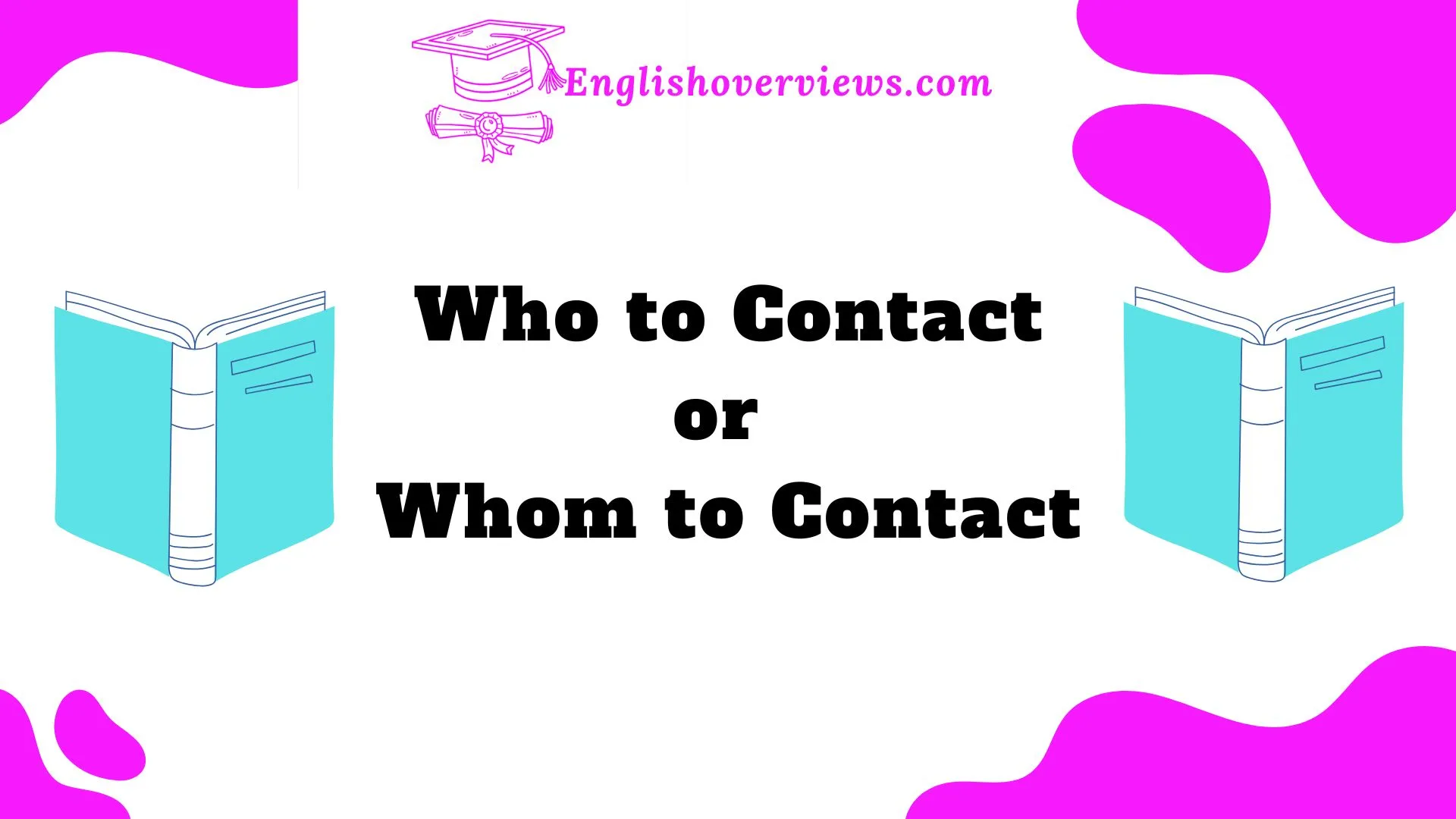When it comes to formal communication, one of the most common questions people ask is whether to use “who” or “whom.” These two words often cause confusion because they seem interchangeable.
However, understanding the difference can elevate your writing and communication, particularly in professional settings.
In this post, we’ll break down the distinction, the traditional rules, modern usage trends, and offer you practical advice on when to use each word.
By the end, you’ll be confident in knowing when to say “who to contact” and when to say “whom to contact.”
Understanding the Confusion: “Who” vs. “Whom”
The words “who” and “whom” both refer to people, but they function differently in a sentence. The main difference lies in their grammatical roles.
- “Who” is a subject pronoun used when the person is the subject of the sentence.
- “Whom” is an object pronoun used when the person is the object of the verb or preposition.
Real-World Examples:
- Who is going to the meeting? (Here, “who” is the subject of the sentence.)
- To whom should I send the invitation? (In this case, “whom” is the object of the preposition “to.”)
While these rules are relatively simple, the real-world usage of “whom” is what trips people up. The modern world’s focus on simplicity and speed has led many to drop “whom” entirely in favor of the easier-to-use “who.”
The Overlapping Meanings and Contextual Use
Although the two words are different grammatically, their meanings often overlap. Both are used to refer to people, and their main difference lies in function rather than meaning.
In many modern contexts, it’s not the word itself that matters, but the clarity of your communication.
For instance, in casual conversation or digital communication, using who instead of whom is often acceptable because it’s easier to say and understand. That said, there are specific cases where whom still shines mainly in formal settings or professional writing.
Examples:
- “Who called me last night?” (This question is informal, and “who” is the correct choice because it’s the subject.)
- “To whom did you send the report?” (This question is more formal, and “whom” is the correct choice because it’s the object of the preposition “to.”)
Key Takeaway:
Use who when referring to the subject of the sentence and whom when referring to the object. This rule, though old-fashioned, still holds value in certain contexts.
The Traditional Grammar Rules
For centuries, “who” and “whom” followed a rigid rule rooted in Latin grammar. In traditional grammar, who was used for the subject of a sentence, and whom was used for the object.
Traditional Usage:
- Who is going to the event? (subject)
- To whom did you address the letter? (object)
Even though this rule was once strictly followed, the modern shift toward conversational, less formal communication has caused many people to let go of the traditional usage. The growing comfort with informal language has made who the go-to choice for both subjects and objects.
However, it’s still important to understand the traditional rules, especially if you’re writing in formal settings like academic papers, official emails, or professional reports.
Modern Usage Trends and Preferences
In today’s language, the use of whom is becoming less common, particularly in spoken English. Many people no longer distinguish between who and whom, often using who in both subject and object positions.
This is more prevalent in the United States, where casual speech and writing take precedence over formal rules.
Example in Modern Usage:
- “Who should I contact for this project?” (Even though technically “whom” could be used here, most people would say “who” for simplicity’s sake.)
This preference for who over whom is even reflected in most style guides. Many modern publications have relaxed their stance on the use of whom, and even the prestigious Associated Press allows “who” in places where “whom” would traditionally be used.
Key Takeaway:
The use of whom is declining in modern usage, but it’s still common in formal and professional writing. If you want to sound formal, it’s best to stick with whom.
The Shift in Language: Analyzing Common Usage
Language is constantly evolving, and this shift is no exception. Historically, whom was used in formal speech and writing, but that’s no longer the case in many parts of the world.
With the rise of informal communication (especially in digital formats like email and text messages), people are more inclined to use who as a catch-all pronoun.
Take this real-world example:
- Email to a colleague: “Do you know who will be attending the conference?”
- Formal report: “To whom should I direct my inquiry about the project?”
In these two scenarios, the same function is being served by who, but the context determines the formality of the word.
Why “Whom” Is Falling Out of Favor
The biggest reason for whom‘s decline is the informality of modern language. People often prefer simplicity, and who is easier to use in spoken and written communication.
With the rise of social media and texting, whom is often seen as a formality that isn’t necessary in everyday conversations.
Key Factors in the Decline of “Whom”:
- Digital Communication: Texts, emails, and social media prioritize quick, easy-to-understand language.
- Speech Patterns: In informal settings, whom sounds stiff and unnatural.
- Cultural Shift: There’s a growing preference for conversational tone, even in professional settings.
Professional Communication: Which Form to Use
When it comes to professional communication, the choice between who and whom can depend on the context. Generally speaking, whom is reserved for more formal writing, such as:
- Legal documents
- Official correspondence
- Academic papers
However, many professional environments now favor the simplicity of who, especially in emails and digital communication.
Example in Professional Communication:
- Whom to contact regarding the issue? (Formal)
- Who should I reach out to for this matter? (More casual, but still professional)
The Role of Formality in Choosing Between “Who” and “Whom”
The level of formality in your writing often dictates the use of whom. For example, in a business email to a colleague, you might use who. However, in a letter to a client or a legal contract, whom would be the correct choice.
When to Use “Whom”:
- In formal writing: Professional emails, reports, and legal documents.
- In formal speech: Public speeches, interviews, and presentations.
When to Use “Who”:
- In casual writing: Texts, emails, and social media posts.
- In informal speech: Conversations with colleagues or friends.
Seeking Formal Guidance: When to Stick with “Whom”
Even though whom is on the decline, there are situations when it’s still best to stick to traditional grammar rules. If you’re unsure, reference reliable grammar sources like:
- The Chicago Manual of Style
- The Associated Press Stylebook
- MLA Handbook
These resources will guide you in knowing when it’s appropriate to use whom versus who, especially in formal writing.
Matching Pronouns with Verbs: Understanding the Grammar
Choosing between who and whom can also depend on the verbs and prepositions used in the sentence.
For example, who is often paired with action verbs, while whom typically follows prepositions like “to” or “with.”
Example of Matching Pronouns:
- “Who is coming to the meeting?” (Here, who is the subject of the sentence.)
- “To whom should I address the letter?” (In this case, whom is the object of the preposition “to.”)
Is “Whom” Still Necessary? Examining Current Standards
While whom still has a place in formal English, many argue that its necessity is fading. In casual conversation and informal writing, using who is generally more acceptable. However, it’s important to strike a balance.
Using whom in the right context—when you want to sound formal or authoritative—can elevate your communication.
Who or Whom in Digital Communication: Does It Matter?
In digital communication, who is generally the preferred choice. Emails, texts, and social media posts tend to be more relaxed, and the rules of grammar take a backseat to ease of communication.
However, in professional emails or official correspondence, it’s still a good idea to stick with whom if you want to maintain formality and professionalism.
How Technology Impacts Grammar Choices
Technology plays a significant role in how we use who and whom. Autocorrect and grammar tools often default to who because it’s more commonly used in both spoken and written language. This reflects how whom is becoming less relevant in the digital age.
Final Recommendations: Opting for Clarity in Your Communications
Ultimately, the most important thing in communication is clarity. Whether you choose to use who or whom, the goal should always be to ensure your message is easily understood. If you’re unsure,
It’s best to go with who in most cases, especially in casual or digital communication.
FAQs
Q: Is it okay to always use “who” instead of “whom”?
A: In informal communication, yes. However, in formal writing, you should stick to traditional rules and use whom when it’s the object of a verb or preposition.
Q: Can “whom” still be used in business emails?
A: Yes, if you want to maintain a high level of formality. However, using “who” is often acceptable, especially in less formal communication.
Q: How do I know when to use “whom” in a sentence?
A: If the word is the object of a verb or preposition, use “whom.” If it’s the subject of the sentence, use “who.”

Alyan Ashraf is the creative mind behind English Overviews, a platform dedicated to helping learners master the English language. Passionate about education and language development, Alyan specializes in simplifying complex English concepts, making learning accessible for students of all levels.











